
|   |

|   |
Australian Diary: Part 1 Interview with Kathakali and Mohiniattam dancer Tara Rajkumar - Dr. Sunil Kothari e-mail: sunilkothari1933@gmail.com Pics courtesy: Tara Rajkumar's Archives July 9, 2009 (This is the first part of an extensive interview. Part 1 deals with Tara Rajkumar's work in London and Part 2 with her work in Melbourne) It was ten years ago that I had first visited Melbourne during my tour of Australia. Tara Rajkumar had performed with her troupe in India and I was able to see her performance and choreographic work Temple Dreaming in Chennai with Chandralekha. Having seen and met the Australian dancer Louise Lightfoot in Mumbai in 1958 at KC College during her lec-dem on Kathakali, and having written about it as a dance critic in The Times of India, I was keen to see Tara's work based upon Louise Lightfoot's memorabilia she had discovered at the Monash University. 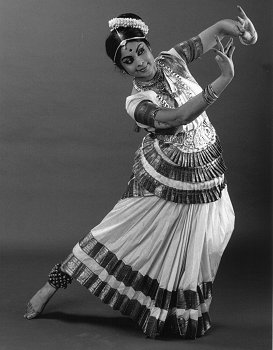 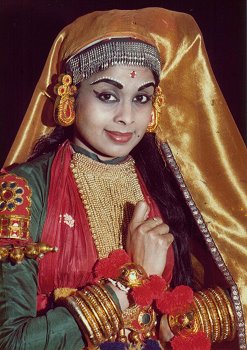 "February 19, 2009 Tara Rajkumar, an Indian Mohiniattam and Kathakali dancer and performing artiste was conferred with the Medal of Order of Australia on 26 January 2009. No mean feat, the award is a culmination of work that started thirty years ago." This is not all. Tara has received a string of prestigious awards and honours for her outstanding contribution to dance in UK, Europe and Australia. Among them I would like to mention the award given by Victorian Government, Victorian Volunteer Award in 2006; Victorian Honour Roll in 2001, she being the first Indo-Australian to receive it; Award for outstanding contribution to Indian Art and Culture in Australia on the occasion of India's Golden Jubilee of Independence and many more awards have come her way for her activities. In England in 1981, she won Ethnic Arts Award and her pioneering work in establishing Indian Academy of Dance now named as Akademi has won her gratitude of the present generation of young dancers in UK. Her work at Bharatiya Vidya Bhavan in London and then during her stay in London, her tours throughout UK and Europe placed her as a front ranking dancer. Not only performances and lec-dems, but also her participation in academic conferences has won her laurels. She was invited to give the keynote address at ASPACEA conference in Melbourne and Bangkok; her writings and research papers are in various anthologies. She is on various committees of Australian Council. The coverage in media both in England and Australia is wide and far reaching. Over the years because of her work, hers is a household name in Melbourne and no wonder the Malayalee Association of Victoria has honoured her with their Annual Encouragement Award. A brilliant speaker, Tara is held in high respect both in England and Australia. It was once again like 'down memory lane' when we started talking. Sunil Kothari: Let us start from the beginning. When did you study Kathakali? Tara Rajkumar: I started learning Kathakali in Bombay when I was about four and a half years old but my initial serious training was from Moleri Namboothiri in Cochin. I was then very fortunate to have my advanced training under the legendary Guru Kalamandalam Krishnan Nair and a brief stint of abhinaya training from the famous Mani Madhava Chakyar. 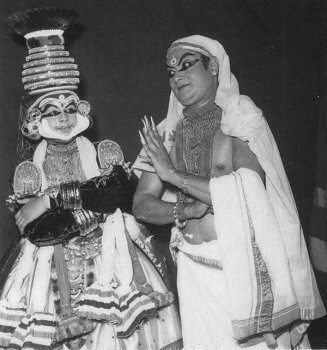 TR: While in Cochin, I was privileged to have been taught Mohiniattam by Guru Kalamandalam Kalyanikutty Amma. Those were the days when the Mohiniattam repertoire was very limited indeed. She was a pioneer. I was mad about dance. My mother reminded me of a program of the famous Kamala Lakshman we had gone to see when I was a four year old, and I stood on my chair and insisted on dancing while watching her. I was certainly inspired by her! Many were the long hours when I trained with my teachers in Cochin. It gave me the classical launching pad on which I was able to build on. But that reminds me, Sunil, of one of my very early performances in which I danced the male role of Krishna with Kalamandalam Krishnan Nair as the Brahmin in 'Rukmini Swayamwaram'! When I think of that I am quite humbled now. He was so generous and kind. SK: When you moved to Delhi, did you continue studying Kathakali? TR: Yes. At the International Centre for Kathakali (ICK), under Guru Punnathoor Madhava Panicker, a great teacher, and I performed many of the male and female roles in the Centre's productions. A landmark performance for me was dancing the role of Mary Magdalene in the Viceroy's Church in Delhi in the presence of the President of India, Dr. S Radhakrishnan. I think in those years, we were just lucky to get such opportunities! By the late 1960's I was a regular Mohiniattam and Kathakali performer and performed widely, with Delhi as my base. The ICK put on many innovative Kathakali dance dramas. In 'Chandalika' produced in1963, I danced the lead female role of Mathangi. A memorable event for me was to have performed at probably the first ever lecture demonstration on Mohiniattam with explanations by Shri MKK Nayar and Kalyanikutty Amma for the Sangeet Natak Akademi. You know well, those were the years when critics like Subbudu encouraged young dancers like us. He liked my work and wrote about it. He even published my photograph on the cover of the well known Tamil magazine Dinamani Kadhir in 1971, when I moved to London to join my husband Rajkumar. In Delhi, I had also received intense training between 1968 and 1971 in Odissi from Guru Surendranath Jena. SK: I did not know about that. TR: Yes, I enjoyed the form. But I concentrated on Kathakali and Mohiniattam. SK: I remember your father TM Bhaskaran Nedungadi. His enthusiasm for Kathakali and arts of Kerala was very deep. TR: My dancing would not have progressed without the encouragement and mentoring by my father. As you know he worked for the Central government and retired as the Joint Chief Controller of Imports and Exports in Delhi. His passion for art, culture, dance and music was phenomenal. You perhaps do not know that he was one of the most trusted disciples of Mahakavi Vallathol. My father took on the challenge of propagating Kathakali almost everywhere, wherever he worked. He was instrumental in establishing a Kathakali club in Cochin in 1950 and the International Centre for Kathakali (ICK) in Delhi in 1961. SK: I used to meet him often. What did he do after his retirement from government service? By 1980, I had moved to Rabindra Bharati University, Kolkata, and had lost touch with him. TR: He was Chairman of Kerala Kalamandalam from 1984 till 1987. During his tenure, he provided commendable leadership to that organization. He was also a prolific writer and created Kathakali Attakathas including Magdalena Mariam and Balidanam and composed songs for Valmiki Prathibha, Geethopadesam and several other stories. Amongst his many activities, he was the Founder and Chairman of the Swati Music Dais in Calicut, Chairman of the Samskrita Vidya Peetam in Balusseri near Calicut and a member of the Bharatiya Vidya Bhavan's Executive Committee in Calicut. Well, our family still misses his enthusiasm and encouragement and his deep knowledge of the arts. SK: Let us pick up the thread. Our meeting in London in the early '70s. When did you arrive in London? TR: In November 1971. My husband Rajkumar had already joined Imperial College after completing his M.Tech in Metallurgy from IIT, Mumbai, and was a Wolfson fellow, pursuing Ph.D in Process Metallurgy, which he received with distinction. 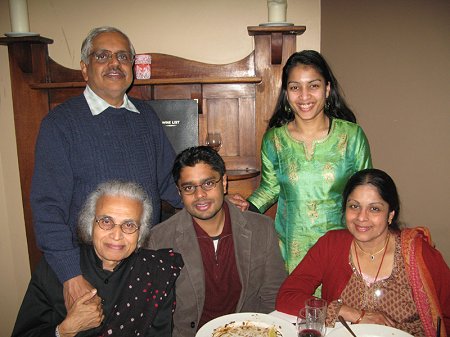 TR: We met in June 1972. My performance at St. Michael's Church Hall was on June 9 for the Bedford Park Arts Festival. You had come to see my performance. I remember Lois Taylor who was working with him, and she had compered the program. SK: My other memories are of our meetings in London at Bharatiya Vidya Bhavan when it was started at Oxford Street. TR: Yes, you had arranged a Festival of Films on Dance bringing films from Films Division from Mumbai. You had asked Ram Gopal to speak on some of the dance forms. And then you had asked me to demonstrate basic stances of Kathakali. I have that article published in Bhavan's journal with me. I hope you can use it, as it has so many leading dancers, critics and important people who helped Bhavan to get established. During your visits to London, we used to give lecture demonstrations together and I remember when we went to Oxford, you had asked me to demonstrate the eye movements like figure of eight, when the British professors and students were so impressed! SK: Tara, of course I remember it. Oh, those were the days! But you had started Academy of Indian Dance and also were at Bhavan, so when did you join Bhavan and in what capacity? TR: I was invited to become the Bhavan's first Honorary Director of Dance in 1977, soon after the Bhavan was established in West Kensington in London under the Chairmanship of Mr. Manek Dalal and Mathoor Krishnamurti as the Registrar. Remember, Prince Charles and Lord Mountbatten had visited the Bhavan then? I was contributing to the Bhavan's work before then, at their first London location in Central London at Oxford Street. 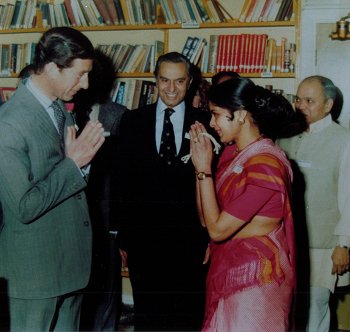 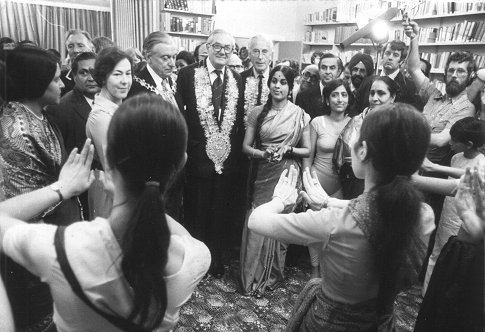 TR: No, the Academy of Indian Dance was set up quite independently and separately in 1979 as a National Academy supported by the British government. Starting with the Bedford Park Festival in 1972, I literally did several full length dance performances and lecture demonstrations all over England, Wales and Scotland for organizations, prestigious universities, museums and festivals and also at many events in Europe between 1972 and 1983. These were well received and generated a lot of interest. I also started teaching Mohiniattam and Kathakali to interested students in London. With a lot of hard work, the need for an Academy to promote South Asian dance gradually received increasing support from the government and many well wishers, and eventually I was able to set up the Academy in 1979 and serve as its Foundation Director. The Academy was set up as a Charitable Trust with a Board of Trustees and an Executive Committee. I was so fortunate to have the famous dancers, Dame Alicia Markova and Ram Gopal as the patrons of the Academy. We commenced operations at the Commonwealth Institute in London with great support from Mr. James Porter, the Director General. SK: Tara, I had attended a Dance Conference of International Dance Council (UNESCO), Paris, held at The Place near Euston, I think in 1980. My book on Bharatanatyam published by Marg was released by Bengt Hagger, the President of International Dance Council during that meeting. You had also arranged seminars, I recall. TR: The Academy held path breaking events including two successful seminal seminars, 'The Contribution of Indian Dance to British Culture' in 1982 and 'The Place of Indian Dance in British Culture' in 1983. My work in the UK also came to the attention of the Government of India. The setting up of the Academy created great interest. I remember that it was mentioned in question time in the Lok Sabha in India! 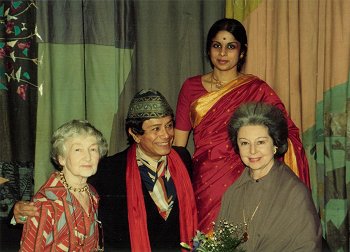 A historic photo taken in 1982 at the seminar on 'The Contribution of Indian Dance to British Culture' organised by the National Academy of Indian Dance in London. Picture shows from left: Eilean Pearcey, who was well known for her dance sketches, the legendary dancers Ram Gopal and Dame Alicia Markova who were patrons of the Academy, and the Director Tara Rajkumar. Photo: Paul Carter TR: The Academy was invited to participate in the successful Festival of India in 1982 coordinated by Pupul Jaykar. We performed at several venues. I was just fortunate that I was at the right place at the right time! It was also great to have a special television production of my work shown during the Festival. I must say I was in good company because another production in the three part series covered the famous film director Satyajit Ray! About the Akademi: Let me show you Akademi's 1980-2006 retrospective for which I wrote a brief article. That explains a lot about my work in London. "After arriving in London in the 1970s, fresh out of college from India, the first few years were rather bleak. Many were the miles I trudged performing and many were the days when I felt I was facing an unyielding wall. But being an eternal optimist, I focused on what lay beyond. Persistence eventually reaped a small grant from the Commission for Racial Equality, and the first National Academy of Indian Dance in England was founded. Key to this success were Dr Tania Rose, officer for the CRE, and Robin Howard, then Director of the London School of Contemporary Dance. Through James Porter and the Commonwealth Institute, where the organization was initially based, the Academy's early activities began to flower. Activities included besides seminars, workshops and performances, giving the events mini-festival status. An all important contribution came from artists like Pratap and Priya Pawar, Shobhana Jeyasingh, Chitra Sundaram and many others who gave generously of their time and effort. One project that was an outright success was an exhibition cum workshop series initiated for the Inner London Education Authority. School after school brought children to learn about Indian dance concepts. A booklet was published and a slide series on the Ramayana produced, illustrating the art of storytelling through dance." SK: Very interesting. TR: In the 1990s, I was informed that the organization I had founded was and is now recognized as a leading provider of South Asian dance education in Britain. Akademi's achievements are many and noteworthy, and I cannot help a certain feeling of pride – a sense that I was perhaps a small spark among many others that set alight a roaming hearth of interest and activity in South Asian dance in Britain today. By keeping a sharp focus on the changing socio-cultural environment and the interactive needs of the dance arts, Akademi continues to grow and shape itself into the foremost contemporary centre for living South Asian dance in the UK. SK: Of course, you deserve all credit for the work which continues in London. Responses Australian Diary: Part 2 Interview with Kathakali and Mohiniattam dancer Tara Rajkumar  Dr. Sunil Kothari, dance historian, scholar, author, is a renowned dance critic, having written for The Times of India group of publications for more than 40 years. He is a regular contributor to Dance Magazine, New York. Dr. Kothari is a globetrotter, attending several national, international dance conferences and dance festivals. He has to his credit more than 14 definitive works on Indian classical dance forms. Kothari was a Fulbright Professor and has taught at the Dance Department, New York University; has lectured at several Universities in USA, UK, France, Australia, Indonesia and Japan. He has been Vice President of World Dance Alliance Asia Pacific (2000-2008) and is Vice President of World Dance Alliance Asia Pacific India chapter, based in New Delhi. A regular contributor to narthaki.com, Dr Kothari is honored by the President of India with the civil honor of Padma Shri and Sangeet Natak Akademi award. He recently received the Senior Critic award from Dance Critics Association, NYC. |